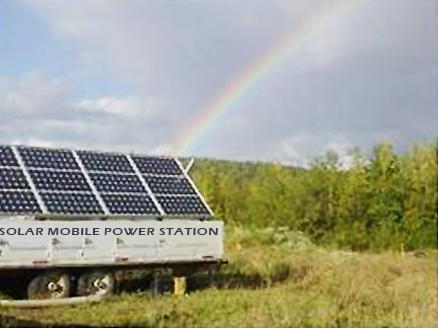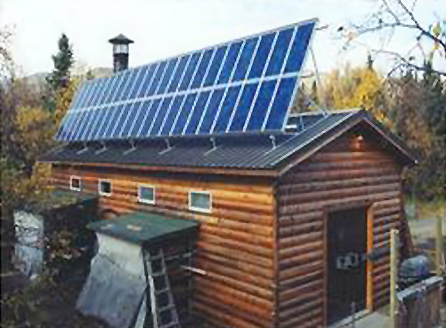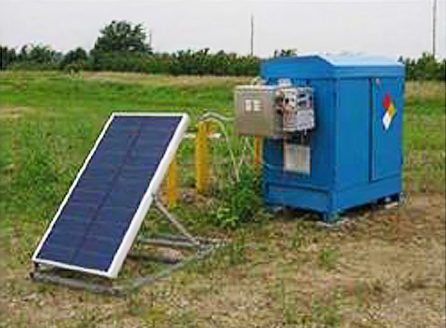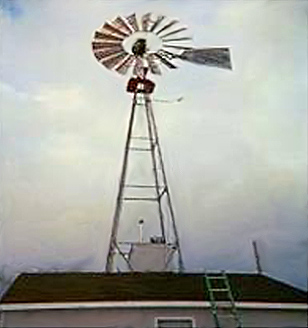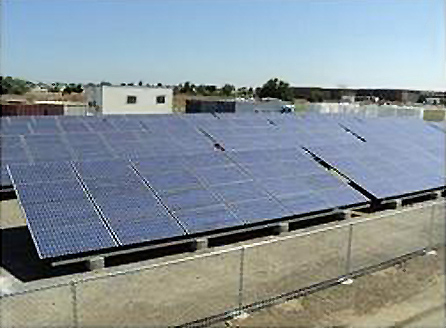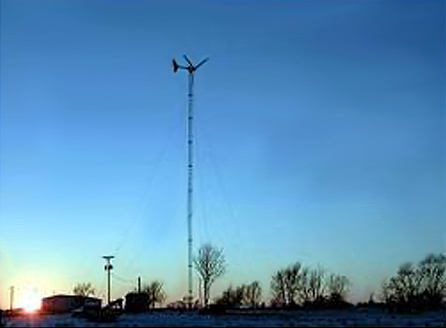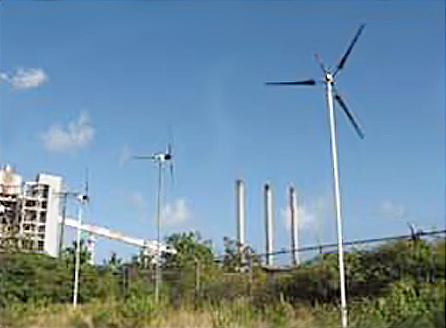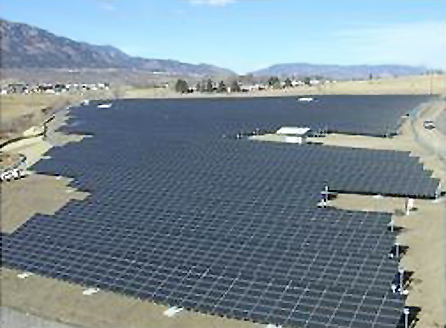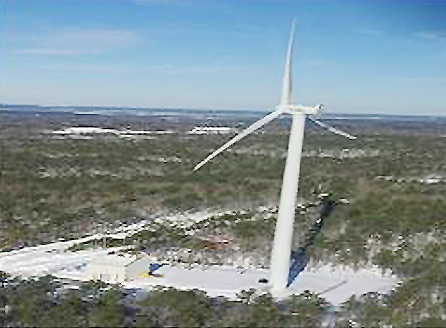Green Remediation Focus
Incorporating BMPs in Renewable Energy Applications
Image Gallery
Fact sheets, web-based software, implementation examples, and general planning reports are available from various federal agencies and partnerships to help project decisionmakers integrate sources of renewable energy into assessment and remediation of contaminated sites. This page contains information on best practices, screening tools and design concepts, site-specific examples, and planning reports related to renewable energy installation and development as part of a green remediation project.
As of October 2022, 502 renewable energy installations![]() with a collective 2.4 gigawatt capacity have been conducted at formerly contaminated lands, landfills, and mine sites. Many of these installations power co-located remediation or monitoring systems or offset ongoing use of grid power to address contaminated environmental media at Superfund sites, federal facilities, or sites undergoing voluntary cleanup.
with a collective 2.4 gigawatt capacity have been conducted at formerly contaminated lands, landfills, and mine sites. Many of these installations power co-located remediation or monitoring systems or offset ongoing use of grid power to address contaminated environmental media at Superfund sites, federal facilities, or sites undergoing voluntary cleanup.
Best Practices
Best Practices for Operation and Maintenance of Photovoltaic and Energy Storage Systems![]() . U.S. DOE/NREL. NREL/TP-7A40-73822. 3rd edition, December 2018.
. U.S. DOE/NREL. NREL/TP-7A40-73822. 3rd edition, December 2018.
Best Practices for Siting Solar Photovoltaics on Municipal Solid Waste Landfills. U.S. EPA and U.S. DOE/NREL. February 2013.
Best Practices Handbook for the Collection and Use of Solar Resource Data for Solar Energy Applications![]() . U.S. DOE/NREL. NREL/TP-5D00-63112. February 2015.
. U.S. DOE/NREL. NREL/TP-5D00-63112. February 2015.
Green Remediation Best Management Practices: Integrating Renewable Energy![]() (6 pp, 840K). U.S. EPA/Office of Superfund Remediation and Technology Innovation. EPA 542-F-22-001. March 2022.
(6 pp, 840K). U.S. EPA/Office of Superfund Remediation and Technology Innovation. EPA 542-F-22-001. March 2022.
Relevant Industry Standards
IEEE Approved Draft Recommended Practice for Testing the Performance of Stand-Alone Photovoltaic Systems. IEEE 1526-2020. IEEE Standards Association.
IEEE Recommended Practice for Installation and Maintenance of Lead-Acid Batteries for Photovoltaic (PV) Systems. IEEE 937-2019. IEEE Standards Association.
Power Performance Measurements of Electricity Producing Wind Turbines. ANSI/AWEA 61400-12-1-2016. American National Standards Institute/American Wind Energy Association.
Requirements for testing, documentation and maintenance - Part 2: Grid connected systems - Maintenance of PV systems. IEC 62446-2.2020. International Electrotechnical Commission.
Standard Practice for Installation, Commissioning, Operation, and Maintenance Process (ICOMP) of Photovoltaic Arrays. ASTM E3010 - 15(2019). ASTM International.
Screening Tools and Design Concepts
Cost of Renewable Energy Spreadsheet Tool (CREST), an economic cash flow model to assess projects involving solar, wind, or geothermal technologies; design suitable cost-based incentives; and evaluate the impact of tax incentives or other support structures. U.S. DOE/NREL.
Database of State Incentives for Renewables & Efficiency (DSIRE), a frequently updated compilation of incentives and policies supporting renewables and energy efficiency in the United States. North Carolina Solar Center and the Interstate Renewable Energy Council, U.S.DOE/EERE, and U.S. DOE/NREL.
Energy Analysis Data and Tools, a compendium of free data and tools for assessing, analyzing, optimizing, and modeling renewable energy and energy efficiency technologies. U.S. DOE/NREL.
Energy Saver: Geothermal Heat Pumps, an overview of ground- and water-source heat pump applications. U.S. DOE/EERE.
Energy Saver: Off-Grid or Stand-Alone Renewable Energy Systems, an overview of using small renewable energy system that are not connected to the electricity grid. U.S. DOE/EERE.
eGRID, a database on the environmental characteristics of electric power generated in the United States. U.S. EPA.
Landfill Gas Energy Cost Model, an Excel-based tool for initial analysis of the economic feasibility of developing a landfill gas energy project. U.S. EPA Landfill Methane Outreach Program.
Power Profiler, an online tool to estimate air emissions associated with electricity consumption in a given zip-code area, based on the fuel mix used by the electricity provider. U.S. EPA.
PVWatts®, an online calculator to determine energy production and cost savings of grid-connected photovoltaic energy systems. U.S. DOE/NREL.
RE Atlas, an interactive mapping tool for identifying available biomass residue, geothermal, solar photovoltaic and onshore wind resources across the United States. U.S. DOE/NREL.
Renewable Energy Potential (reV) Model, a detailed spatiotemporal modeling assessment tool that empowers users to calculate renewable energy capacity, generation, and cost based on geospatial intersection with grid infrastructure and land-use characteristics. U.S. DOE/NREL.
REopt: Renewable Energy Integration and Optimization, a tool for simulating impacts of integrating geothermal, solar, wind, and combined heat and power systems. U.S. DOE/NREL.
RE-Powering Mapper, an online tool providing preliminary screening results on renewable energy potential at contaminated lands, landfills, and mine sites tracked by the U.S. EPA and select state agencies. U.S. EPA.
RETScreen clean energy project management software. Natural Resources Canada.
Siting a Project, an overview of factors such as wind resource and compatibility of land/area, environmental impacts and community input. American Wind Energy Association.
Whole Building Design Guide: Renewable Energy, a resource guide to increase energy and resource efficiency of federal buildings and facilities. National Institute of Building Sciences.
WINDExchange, a web-based platform with data, analytical tools and information for evaluating wind resources, site selection, economic costs and incentives, wildlife impacts and community impacts concerning distributed or utility-scale wind projects. U.S. DOE.
Site-Specific Examples
Alternative Energy at Superfund Sites. U.S. EPA Superfund Redevelopment Initiative.
Alternative Energy: From a Toxic Past to a Renewable Future. U.S. EPA Superfund Redevelopment. 2012. ![]()
Profiles of Green Remediation. Core Elements, Energy: Renewable. CLU-IN. U.S. EPA
Green Remediation and the Use of Renewable Energy Sources for Remediation Projects![]() (55 pp, 627.96K). Amanda Dellens, EPA/OSWER fellowship. August 2007.
(55 pp, 627.96K). Amanda Dellens, EPA/OSWER fellowship. August 2007.
Groundwater Remediation Powered by a Renewable Energy Source![]() (72 pp, 2.5MB). Curt Elmore and Ron Gallagher, Missouri University of Science and Technology (formerly University of Missouri-Rolla). September 2005.
(72 pp, 2.5MB). Curt Elmore and Ron Gallagher, Missouri University of Science and Technology (formerly University of Missouri-Rolla). September 2005.
Solar Farm at Superfund Redevelopment Site in Kokomo, Indiana. U.S. EPA. ![]()
Technology News and Trends, highlighting site remediation projects with onsite renewable energy systems. U.S. EPA/OSWER. Issue No. 47: EPA 542-N-10-002. April 2010.
Technology News and Trends, highlighting green remediation strategies including use of renewable energy sources to power treatment systems. U.S. EPA/OSWER. Issue No. 36: EPA 542-N-08-003. May 2008.
Technology News and Trends, highlighting site remediation projects with onsite renewable energy systems. U.S. EPA/OSWER. Issue No. 30: EPA 542-N-06-009. May 2007.
Related Planning Reports
A Guidebook on Grid Interconnection and Islanded Operation of Mini-Grid Power Systems Up to 200 kW. Lawrence Berkeley National Laboratory. 2013.
An Overview of Renewable Natural Gas from Biogas. U.S. EPA. EPA 456-R-21-001. January 2021.
CHP Project Profiles Database. Better Buildings. U.S DOE.
Community Solar: An Opportunity to Enhance Sustainable Development on Landfills and Other Contaminated Sites. U.S. EPA. December 2016.
Interconnection: Plugging RE-Powering Sites into the Electric Grid. U.S. EPA RE-Powering America's Land Initiative. October 2019.
Landfill Gas Energy Project Development Handbook. U.S. EPA Landfill Methane Outreach Program. July 2021.
Liability Reference Guide for Siting Renewable Energy on Contaminated Properties. U.S. EPA. July 2014.
Mobile Energy Storage Study: Emergency Response and Demand Reduction. Massachusetts Department of Energy Resources. February 1, 2020.
Small Community Wind Handbook. U.S. DOE Office of Energy Efficiency & Renewable Energy
Solar Power Installations on Closed Landfills: Technical and Regulatory Considerations![]() (36 pp, 1.16MB). Gabriel Sampson, U.S. EPA/OSWER fellowship. September 2009.
(36 pp, 1.16MB). Gabriel Sampson, U.S. EPA/OSWER fellowship. September 2009.
Superfund Landfill Methane-to-Energy Pilot Project![]() (143 pp, 7.51MB). U.S. EPA/OSWER Office of Superfund Remediation and Technology Innovation. OSWER 9200.081. December 2010.
(143 pp, 7.51MB). U.S. EPA/OSWER Office of Superfund Remediation and Technology Innovation. OSWER 9200.081. December 2010.




